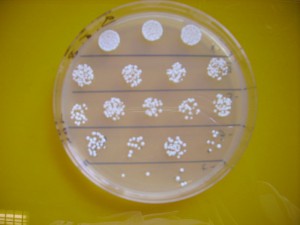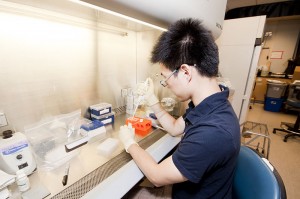Brettanomyces bruxellensis (also known as Dekkera bruxellensis), or what the wine community lovingly calls “Brett”, is a huge cause of economic decline in the wine business as a result of the yeasts’ ability to decrease the quality of wine on a grand scale, though this fact remains very controversial in the industry. While many believe that Brett is bad for wine quality, producing ethyl phenols that increase the incidence of “off” aromas in wine (including “barnyard”, “Band-Aid”, “phenolic”, etc), there are few others that believe that Brett character is critical in giving wine individual flavor characteristics and expression of terroir.
Chemically, Brettanomycesyeasts possess hydroxylcinnamate decarboxylase activity and vinylphenol reductase activity, both of which function to convert hydroxylcinnamic acids into the ethyl phenols responsible for “off” aromas and

By Maxdesbacchus (Own work) [GFDL (http://www.gnu.org/copyleft/fdl.html) or CC-BY-SA-3.0-2.5-2.0-1.0 (http://creativecommons.org/licenses/by-sa/3.0)], via Wikimedia Commons
In regards to ethyl phenols, which are produced by the Brett yeasts, the sensory threshold is very low, thus even low levels of these compounds in the wine result in detectable “off” flavors and aromas that often result in a marked decrease in wine quality. Though the Brett character is often off-putting to some, others find the flavors and aromas desirable and indicative of terroir, which makes the presence of Brettanomyces in wine controversial to say the least.
From a microbiology stand point, monitoring Brettanomyces can be problematic, as the yeast can be difficult to distinguish strain diversity in a population of Brett using current analytical methods, it has a relatively slow growth rate, and it is very difficult to isolate from media and other yeasts. Another very important and problematic characteristic of Brett is that it can enter what is known as a “viable but not cultivable” state after the addition of sulfur dioxide to the wine. In other words, Brett is unable to grow under the high free sulfur dioxide conditions, but can continue to grow at a later time after the wine has had some time to evolve.
Unfortunately, Brett detection protocols are sometimes performed during this stage of “viable but not cultivable”, which results in a false negative reading. To say it another way, the cellar worker is “tricked” into thinking that the winery is sterile, however the Brett is merely just “laying low” and remaining temporarily undetectable using traditional detection methods. The current methods for measuring Brett are not sensitive enough to detect the yeast when in this stage, thus running the risk of the wine developing Brett character later on when the yeasts “wake up”, so to speak.
A recent study by Tofalo et al (2012) aimed to find a different method for measuring Brettanomyces yeasts in wine, in hopes that a more sensitive method can be utilized and employed in wineries all over the world, potentially saving wineries a financial headache later on. Specifically, the method tested in this

By Kevin Tong, UC Davis College of Engineering (Ghausi Hall Labs) [CC-BY-2.0 (http://creativecommons.org/licenses/by/2.0)], via Wikimedia Commons
Methods (very very briefly)
30 red wine samples were collected from vineyards in central Italy (specifically, the Abruzzo region). 5 of these samples were from organically managed vineyards, while the other 25 samples were from conventionally managed vineyards. All wine samples were positive for Brettanomyces bruxellensis.
Wine samples were diluted in a serial dilution and plated onto an enrichment medium (designed to isolate Brett). Yeast colonies were counted after 12 days of 25oC incubation.
DNA was extracted from the yeast colonies using previously performed methods.
qPCR was performed on the DNA samples.
All samples at all stages were performed in triplicate.
Different DNA extraction kits were compared in order to determine which resulted in the highest quality DNA for qPCR analysis.
Results
- Brettanomyces was not detected in 20 of the 30 wine samples using the plating count method, even though these wines were previously confirmed to be Brett positive.
- 16 of these samples were from conventional vineyards, and 4 were from organic vineyards.
- The DNA extraction kit that provided the highest quality DNA for qPCR analysis was the DNAPowerSoil Isolation Kit. This was the only kit used for further analysis.
- According to the authors, the results of this kit were “fast, simple, and efficient”.
- Using qPCR, Brettanomyceswas detected in 22 of the 30 wine samples (as opposed to only 10 of 30 using the plating count method).
- Concentrations of Brett ranged from 10 to 104 CFU/mL, with organic wine samples harboring the lower concentrations of the bunch.
- According to the authors, these results indicate that Brett is detectable at levels of at least 10 CFU/mL.
Conclusions
The results of this study indicate that using qPCR instead of traditional plating or culture count methods is superior in regards to detecting Brettanomyces in wine. The authors noted that qPCR was able to identify 12 more wine samples to be Brett positive than the plating count method could detect.
It is important to note that 8 of the wines still did not give positive results in either the plating method or the qPCR method, indicating that there are more complicated factors “clouding up” the detection of Brett in the samples, questioning whether or not there are potentially even more sensitive assays available that what had been tested in this study. The authors noted it is very

By Quinn Dombrowski (originally posted to Flickr as Wine) [CC-BY-SA-2.0 (http://creativecommons.org/licenses/by-sa/2.0)], via Wikimedia Commons
The authors also noted that different strains of Brettanomyces have different abilities to produce ethyl phenols, thus simply counting the numbers of Brett cells in the wine may or may not be indicative of wine spoilage. Specifically, a strain of Brett that does not produce much ethyl phenol could potentially be present in very high concentrations and still not spoil the wine, while another strain of Brett that has the ability to produce exorbitant levels of ethyl phenol only needs to be present in small numbers before spoiling the wine it inhabits.
In summary, while there is still room for improvement, this study showed that qPCR may be a more effective way to monitor Brett levels in wine, and may be a good practice for wineries to adopt in their Brettanomyces management protocols. Certainly, more research needs to be done (i.e. would this method be just as effective in white wines?), but this study provides a more sensitive alternative to the traditional Brett detection methods that could be financially beneficial to wineries.
Source: Tofalo, R., Schirone, M., Corsetti, A., and Suzzi, G. 2012. Detection of Brettanomyces spp. in Red Wines Using Real-Time PCR. Journal of Food Science 77 (9): M545-M549.

7 comments for “Detecting Brettanomyces in Wine: A Novel Approach Using qPCR”